
Author Centered Publisher of Print and Digital Scholarly Content
|
||||

8x10in; 302p; Color Pbk: ISBN 979-8666480915 $54.99 HC: ISBN 978-0998172736 $69.99 eBook: $29.99 Volume Discount: 5-14(50%) 15-29(55%) 30-50(60%) |
||||
This handbook is a reference tool intended to help authors, scholars, and anyone else provide accurate and standardized quotations from the Quran, both from linguistic and historical perspectives. The first volume of the handbook includes the full text of the Quran using a font mimicking its earliest script, Mashq or Early Kufic, and it is provided in two formats, with and without diacritic vowel marks. The font used to generate the full texts in the first volume, Arabetics Mashq, was designed and implemented by the author after years of in-depth research of the actual historical Quranic manuscripts, notably the copy of Muṣḥaf ʿUthmān kept today in the Topkapi Museum in Turkey. The second volume of the handbook also includes two full texts of the Quran. The full text of the first part is a complete, word-by-word Latin transliteration of the modern Arabic script full text of the Quran, using the ALA-LC Romanization Standards. The second part includes a modern Arabic script full text of the Quran, including the full set of modern Arabic diacritic vowel marks. It is generated using Arabetics Latte, a multilingual font designed and implemented by the author to emphasize simple, clear shapes, and facilitate easy reading. Letters change shapes only minimally and are designed to have a large x-height. The diacritic vowel marks are placed intentionally away from the letters for clarity. Reading the Quran in this font can be very helpful to both native and non-native Arabic readers. The full text of the Quran contained in this book is based on the Tanzil Quran Text, a carefully produced, highly verified and continuously monitored text by a group of specialists at Tanzil project. Possibly, this handbook includes the first Latin transliterated copy ever of the Quran using the ALA-LC Romanization Standards. Both volumes include indexes for Quran chapters and verses and the necessary tables needed to help the readers understand the early Quranic Kufic script and the ALA-LC Romanization Standards.
Availability Includes: Amazon(Pbk; HC) BN(HC) Google(ebook) |
||||
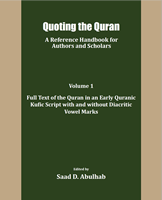
8x10in; 302p; Color Pbk: ISBN 979-8666474983 $54.99 HC: ISBN 978-0998172712 $69.99 eBook: $29.99 Volume Discount: 5-14(50%) 15-29(55%) 30-50(60%) |
||||
This handbook is a reference tool intended to help authors, scholars, and anyone else provide accurate and standardized quotations from the Quran, both from linguistic and historical perspectives. The first volume of the handbook includes the full text of the Quran using a font mimicking its earliest script, Mashq or Early Kufic, and it is provided in two formats, with and without diacritic vowel marks. The font used to generate the full texts in the first volume, Arabetics Mashq, was designed and implemented by the author after years of in-depth research of the actual historical Quranic manuscripts, notably the copy of Muṣḥaf ʿUthmān kept today in the Topkapi Museum in Turkey. The second volume of the handbook also includes two full texts of the Quran. The full text of the first part is a complete, word-by-word Latin transliteration of the modern Arabic script full text of the Quran, using the ALA-LC Romanization Standards. The second part includes a modern Arabic script full text of the Quran, including the full set of modern Arabic diacritic vowel marks. It is generated using Arabetics Latte, a multilingual font designed and implemented by the author to emphasize simple, clear shapes, and facilitate easy reading. Letters change shapes only minimally and are designed to have a large x-height. The diacritic vowel marks are placed intentionally away from the letters for clarity. Reading the Quran in this font can be very helpful to both native and non-native Arabic readers. The full text of the Quran contained in this book is based on the Tanzil Quran Text, a carefully produced, highly verified and continuously monitored text by a group of specialists at Tanzil project. Possibly, this handbook includes the first Latin transliterated copy ever of the Quran using the ALA-LC Romanization Standards. Both volumes include indexes for Quran chapters and verses and the necessary tables needed to help the readers understand the early Quranic Kufic script and the ALA-LC Romanization Standards.
Availability Includes: Amazon(Pbk; HC) BN(HC) Google(ebook) |
||||
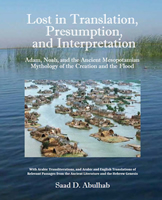
8x10in; 202p; Color Pbk: ISBN 9798630345981 $44.99 HC: ISBN 978-0984984398 $59.99 eBook: $24.99 Volume Discount: 5-14(50%) 15-29(55%) 30-50(60%) |
||||
This book investigates the Mesopotamian roots of two key monotheist characters, Adam and Noah, and their stories, through an exhaustive reading of relevant texts from the ancient literature; it includes original Arabic transliterations, and Arabic and English translations of sections from Akkadian and Sumerian inscriptions, and the Hebrew Genesis. The common, biblical beliefs in an initial, single human creation, and a subsequent survival of a punishing, catastrophic flood were among the key forming pillars of the Near East monotheist religions. The other key pillar was, arguably, the belief in the existence of a one, supreme god and creator. However, neither the two stories of human creation and catastrophic flood, nor the belief in one supreme god, were originally introduced by these monotheist religions. Key inscriptions from ancient Mesopotamia have clearly indicated that various versions of these beliefs were commonplace for thousands of years before. Despite the differences in details, and at times ambiguities, the monotheist faiths seem to have derived their defining themes from one source: early Mesopotamian mythology. Unfortunately, several key inscriptional facts supporting this hypothesis were lost in the current transliterations, translations, and interpretations of the ancient texts. The work presented in this book attempts to highlight these historical facts.
Availability Includes: Amazon(Pbk; HC) BN(HC) Google(ebook) |
||||
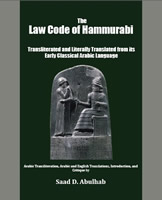
8x10in; 222p; Color Pbk: ISBN 97819813409038 $44.99 HC: ISBN 9780998172705 $59.99 eBook: $34.99 Volume Discount: 5-14(50%) 15-29(55%) 30-50(60%) |
||||
The text of the Hammurabi stele offers students of both Arabic and Assyriology a perfect and unique opportunity to identify the language and grammar of its ancient Arabic language. Its vocalizations of subjects, objects, verbs, and genitives are astonishingly identical to that of classical Arabic. The loose and sometimes “chaotic” placement of words in sentences is strikingly identical to that of pre-Islamic Arabic. In fact, the older the formal Akkadian language it seems the clearer its Arabic identity!
Offering a textbook reference value, the author provided the numbered, phonetic Latin transcription for each law right above its corresponding, numbered Arabic transcription. Furthermore, he translated the text of each law literally, into Arabic and English, to illustrate how its translation was concluded, and to preserve its overall linguistic style, accounting for every word in its actual text. For easier reading experience, a full subject guide to the laws of Hammurabi is provided. All reference entries from both the historical Arabic manuscripts and the modern dictionaries of Assyriology are also provided in the appendix. In his expanded introduction, the author discussed the layout, script, and language of the Hammurabi code stele in the Louvre, and through the evidence of Hammurabi’s own words in a key paragraph in his prologue, he offered the possible meanings of the nickname Hammurabi.
Availability Includes: Amazon(Pbk; HC) BN(HC) Google(ebook) |
||||
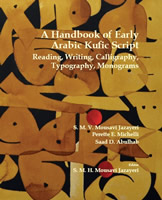
8x10in; 298p; Color Pbk: ISBN 9781542565738 $89.99 HC: ISBN 9780998172743 $99.99 eBook: $34.99 Volume Discount: 5-14(50%) 15-29(55%) 30-50(60%) |
||||
A comprehensive textbook of the early Arabic Kufic script, written as a complete reference book for calligraphers, designers, and students of art history and the history of Arabic language and scripts. This beautiful and powerful script was derived from the earlier Hijazi Mashq style of Mecca and Medina, which was invented by early Muslim scribes to record the Quran. Today, the many historical manuscripts displayed in numerous museums around the world can attest to development and evolution of this remarkable and versatile script. Authored by master calligrapher, Mousavi Jazayeri, this book is the only book written in English that is solely dedicated to the study, learning and revival of the fascinating script behind the first mature Arabic calligraphic style, which was the official script of the Islamic Near East for centuries, before being replaced by the modern Naskh style. In this handbook, Mousavi Jazayeri who had discovered the lost art of cutting the qalam (pen) for early Kufic more than twenty years ago, explains with detailed, clear illustrations how to write early Kufic using a calligraphic pen and even a regular pen. He guides students patiently through the process involved in creating amazing, modern monograms. With clear, ample examples taken from the old Quranic manuscripts, art history students, font designers, and scholars of the history of the Arabic language and scripts can use this reference book to learn the key aspects of the early Kufic script as a writing system. Mr. Mousavi Jazayeri is joined by two co-authors, Perette E. Michelli, a multi-disciplinary historian of medieval and later art, and Saad D. Abulhab, a known Arabic type designer and independent scholar of the history of Arabic language and scripts. The two co-authors are members of the first international group dedicated to the study and revival of the early Kufic script, Kuficpedia, which was formed a few years ago around the historical achievements of Mr. Mousavi.
Availability Includes: Amazon(Pbk; HC) BN(HC) Google(ebook) |
||||
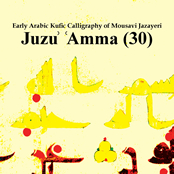
8.5x8.5in; 142p; Color Pbk: ISBN 9781539698715 $39.99 eBook: $24.99 Volume Discount: 5-14(50%) 15-29(55%) 30-50(60%) |
||||
Part 30 of the Quran, Juzu' 'Amma, written in the early Arabic Kufic calligraphy style, by Iranian master calligrapher Mousavi Jazayeri
Availability Includes: Amazon(Pbk; HC) BN(HC) Google(ebook) |
||||
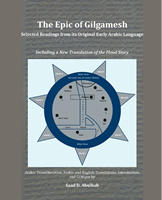
8x10in; 388p; B&W Pbk: ISBN 9781539315902 $43.99 HC: ISBN 9780998172729 $58.99 eBook: ISBN 9780998172736 $29.99 Volume Discount: 5-14(50%) 15-29(55%) 30-50(60%) |
||||
The pioneering work presented in this book introduces the earliest known literary and mythology work in the world, the Epic of Gilgamesh, in its actual language: early Classical Arabic. It provides a more accurate translation and understanding of the important story of the flood, one of the key stories of the monotheistic religions. In this book, the author, a known Arabic type designer and an independent scholar of Nabataean, Musnad, and early Arabic scripts, was able to decipher the actual meanings and pronunciations of several important names of ancient Mesopotamian gods, persons, cities, mountains, and other entities. He was able to uncover the evolution path of the concept of god and the background themes behind the rise of the monotheistic religions. By “digging out” the actual language of the epic, he was not only able to resurrect the actual word soundings and linguistic literary style of its original text, but also to provide more accurate and coherent translations. Following his three years of research, he was able to demonstrate through undisputed linguistic evidence that the epic was in fact written in a beautiful, powerful early Classical Arabic language! And the so-called Sumerian and Akkadian languages that the epic was recorded with, which we are told today are unrelated languages, were in fact one evolving early Arabic language, written with one evolving writing system, passing through two major time periods. Although this book is primarily written as a reference textbook for scholars, it is equally suitable for anyone interested in reading the translation of the Epic of Gilgamesh, a fascinating Mesopotamian Arab mythology work documenting eloquently some of the most important and lasting ancient myths invented by humankind.
Availability Includes: Amazon(Pbk; HC) BN(HC) Google(ebook) |
||||
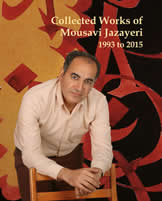 8x10in; 289p; Color Pbk: ISBN 9781517104931 $69.99 Volume Discount: 5-14(50%) 15-29(55%) 30-50(60%) |
||||
This catalog contains a selected collection of Mousavi Jazayeri's works from 1993 until 2015. It includes a rich gallery of his manuscript and ceramic calligraphy works, his calligraphic art paintings, and his numerous logotype designs. Seyed Mohammad Vahid Mousavi Jazayeri is an established Iranian calligrapher, researcher, graphic designer and expert in early Arabic Kufic script. He has introduced groundbreaking achievements since his rediscovery of the lost art for cutting the qalam (pen) for early Kufic, twenty years ago. Born in 1969, Vahid holds a Bachelor of Art in Graphics. He has published extensively and held numerous workshops on reviving the early Quranic Kufic calligraphic style. Vahid started his career studying the Thulth and Naskh scripts in 1982 and after nearly ten years of training he began teaching in Tehran art schools from 1991. Within a year, he was producing significant work in two additional fields: historical calligraphy research in a range of media (ceramics, coins, plaster and stone, as well as manuscripts) and contemporary type design.
|
||||
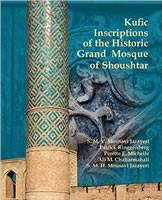 8x10in; 234p; Color Pbk: ISBN 9781511537995 $79.00 Volume Discount: 5-14(50%) 15-29(55%) 30-50(60%) |
||||
The authors of this book have taken a rare opportunity to bring together the many factors crucial to an adequate understanding of architectural inscriptions, and they have done so in relation to those in an important but sadly under-published historic mosque. The grand mosque of Shoushtar contains many historic inscriptions installed over time for documentary purposes, but the four monumental Kufic texts are integral parts of its design and meaning. They are here studied calligraphically, hermeneutically and phenomenologically, and in relation to the structure of the mosque itself, the whole being set against an outline of Shoushtar’s history and the features of the mosque. Begun in the ninth century CE, the grand mosque of Shoushtar is one of the earliest hypostyle mosques in Iran. This mosque is idiosyncratic and much modified and now presents a complex interpretational challenge. This book is an important and long overdue contribution to our knowledge of Shoushtar and the historic application of monumental Kufic inscriptions. Its high quality illustrations allow personal study of all four Kufic inscriptions of the city’s grand mosque: Surat Ya-Sin which was once encircling the entire prayer hall, the dedicatory inscription above the secondary internal mihrab, its fascia inscription containing the last two verses of Surat al-Isra’ whose content parallels the fourth inscription of Surat al-Ikhlas (al-Tawhid) on the external mihrab.
|
||||
 13x8.5in; 42p; Color Pbk: ISBN 9780984984381 $24.00 International Edition
|
||||
This new work by Seyed Muhammad Vahid Moussavi Jazayeri is the complete Surat al-Waqi'ah (Surah 56, The Inevitable, The Event). This Surah describes the Resurrection and the division of people into three sorts. Those on the right are destined for the Gardens of Paradise, the foremost are first among those destined for Paradise, and those on the left are destined for the fires of Hell. In the surah, relatively short descriptions of Paradise alternate with long, harsh descriptions of Hell. An exceptional spirituality, nobility, and harmony of the letters and the lines distinguish the Quranic Kufic calligraphy of artist and calligrapher Seyed Vahid Jazayeri. One clearly feels the congruence and dialogue between the letters, and despite the licit differences between the letter shapes, the words are always in harmony, composed to produce beautiful pages. The ease and soul of the artist's writing is lucidly communicated, while preserving a great heritage from loss and disappearance. The unpretentious writings of Seyed Jazayeri penetrate the mind and the soul due to the sacred nature of this style of calligraphy used in writing the earliest Qurans.
Availability Includes: Amazon(HC) |
||||
 13.5x5.7in; 88p; Color HC: ISBN 9780984984374 $349.00 Limited Print Edition
|
||||
In this limited print book, Iranian calligraphy master Seyed Mohammad Vahid Mousavi Jazayeri shares his relentless journey to bring alive a magnificent, but largely forgotten, calligraphy art: the early Arabic Kufic calligraphy. In his new generous calligraphy masterpiece that is made available openly in this limited edition print book he does not present the usual "few sentences" seen in most modern calligraphy works, but a complete manuscript. After all, the true challenge of script calligraphy is not only its visual and aesthetic quality and consistency but its utility as a reading and documenting medium. Mousavi Jazayeri's chosen manuscript for his new endeavor is the Glorious Quran, the book that early Kufic was conceived for originally. In the many pages of this astonishing resurrected Quranic manuscript, Mousavi Jazayeri not only invites its readers to absorb the magnificent spiritual teachings of Surat al-Mulk, but he dares them to become living witnesses of a great, long-gone Islamic age. This limited edition book is envisaged as the first of a series of books that will eventually reproduce, surah by surah, a full modern-day copy of the Quran in its earliest script: the Arabic Kufic script.
Availability Includes: Amazon(HC) |
||||
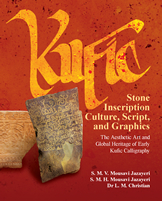 8x10in; 244p; Color Pbk: ISBN 9781492336723 $74.00 HC: ISBN 9780984984329 $89.00 eBook: ISBN 9780984984367 $34.00 Volume Discount: 5-14(50%) 15-29(55%) 30-50(60%) |
||||
This reference book studies the script, art, and culture of the early Arabic Kufic calligraphy. It presents around hundred historical stone inscriptions, coins, and manuscripts from early-Islamic Persia. In their book, the primary author and famed Iranian early Kufic expert and calligrapher, S.M.V. Mousavi Jazayeri, and his fellow co-authors read and analyze with meticulous detail the calligraphy, script, and art work of thirty-seven Kufic gravestone inscriptions, mainly from the Yazd providence of Iran. The carefully-selected inscriptional sample in this book illustrates the remarkable power and versatility of this early script, and the extent of the global role played by it in shaping societies and cultures of a vast area extending from China to Spain.
Availability Includes: Amazon(Pbk; HC) BN(HC) Google(ebook) |
||||
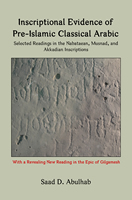 6x9in; 234p; B&W Pbk: ISBN 9780984984343 $34.99 HC: ISBN 9780984984336 $49.99 eBook: ISBN 9780984984350 $29.99 Volume Discount: 5-14(50%) 15-29(55%) 30-50(60%) |
||||
This book discusses a highly-debated research topic regarding the history of the Arabic language. It investigates exhaustively the ancient roots of Classical Arabic through detailed tracings and readings of selected ancient inscriptions from the Northern and Southern Arabian Peninsula. Specifically, this book provides detailed readings of important Nabataean, Musnad, and Akkadian inscriptions, including the Namarah inscription and the Epic of Gilgamesh. In his book, the author, a known Arabic type designer and independent scholar, provides clear indisputable transcriptional material evidence indicating Classical Arabic was utilized in major population centers of the greater Arabian Peninsula, many centuries before Islam. He presents for the first time a new clear reading of Classical Arabic poetry verses written in the Nabataean script and dated to the first century CE. Furthermore, he offers for the first time a clear detailed Classical Arabic reading of a sample text from two ancient editions of the Mesopotamian Epic of Gilgamesh, separated by more than1000 years.
Availability Includes: Amazon(Pbk; HC) BN(HC) Google(ebook) |
||||
 6x9in; 240p; B&W Pbk: ISBN 9781466391468 $39.99 HC: ISBN 9780984984305 $54.99 eBook: ISBN 9780984984312 $29.99 Volume Discount: 5-14(50%) 15-29(55%) 30-50(60%) |
||||
A comprehensive reference on the history of Arabic Language and script, which goes beyond the sole discussion of technical matters. It studies objectively the evidence presented by modern-day western archeological discoveries together with the evidence presented by the indispensible scholarly work and research of the past Islamic Arab civilization era. The book scrutinizes western theories about the history of the Arabs and Arabic language and script in connection with the roles played by Western Near East scholarship, religion and colonial history in the formation of current belief system vs. Arab history and language, which is an essential step to study this correlated and complex topic objectively. In his book, the author explores the relevant facts of history and geography as crucial defining factors in the study of history of Arabic language and script. He offers a brief balanced account on the important topic of Muhammad leadership and Islam in the formation of Arabia, and investigates the Quran as a key evidence and reference of the Arabic language and script.
Availability Includes: Amazon(Pbk; HC; Kindle) BN(HC) Google(ebook) |
||||